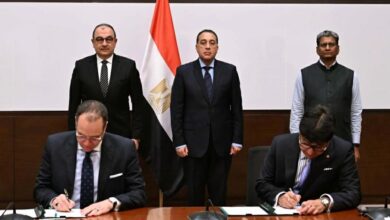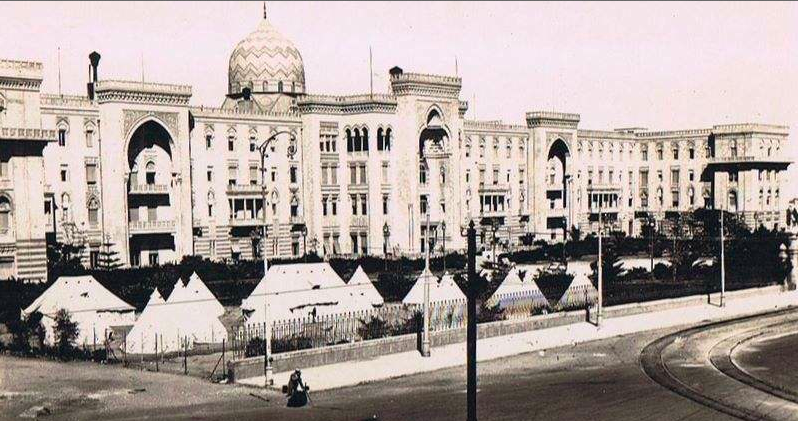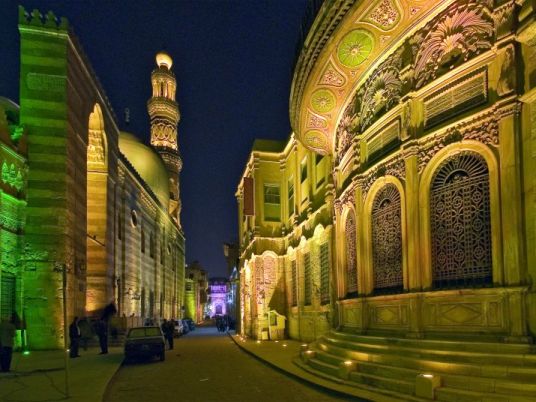At first glance it seems that Cairo, the 'Protected One', the capital of Sultan Al-Moez, is a city that is inflexible toward progress. It is just enough to know that Greater Cairo (Cairo, Giza and Qalyubiya) has a population of nearly 22 million, holds almost half of the cars in Egypt, and is in fact the end result of a collection of several capitals, including: Memphis, the Coptic Capital in Ancient Egypt, Fustat, al-Qata'i, the Fatimid, Ayyubid, and the Khedival eras; as well as the more modern Heliopolis; and Nasr City; and most recently, New Cairo, and 6th of October City.
All of the cities mentioned held a position of power in Egypt, since the Pharaohs, with their Pyramids of Giza, and up until the modern era.
Whether the ruler is in the Cairo Citadel, Ras el-Tin Palace or Ittihadeya Palace, the capital's place was at that sliver of land, linking Upper Egypt to Lower Egypt, according to the direction of the immortal river, ever-flowing upstream, the Nile.
History seems, in all cases, a platform on which civilization is cascaded to another era, constant through changing ages and conditions. But the present time seems to be different. This degree of congestion, which has never been seen in any era before, and the stifling traffic, surrounded by slums like a bracelet on a wrist.
Though the city's most serious dilemmas are seemingly hopeless, they show a strong precedent of the ability to overcome. Eliminating certain neighborhoods didn’t work, and increasing roads didn't solve the issue, nor did bridges and tunnels benefit the situation.
Plus, there is now a fresh challenge to the capital from a new, more modern entity — even if it modestly hides under the name "Administrative" — which is being built from scratch, using the latest technologies known to man.
In truth, there is no reason for jealousy between the ancient capital and the new, as Cairo's art lies in its ability to accommodate all capitals that may arise. Moreover, the "Administrative" is apparently to ultimately become a bridge between the river and the sea, between New Cairo and the Gulf of Suez.
It is the official district of a capital saturated by official districts, and it is time for it to breathe and enjoy what it has and what it contains.
And this is likely what the Cairo Heritage project is set for — sought after by a distinguished group of experts, led by Engeneer Ibrahim Mehleb, assistant to the president for national projects. The idea, according to some discussions I've heard recently, revolves around the concepts of resurrection, revival and renaissance — something being overcome by time, its condition deteriorating, its value dropping, decomposing, or even being on the verge of death.
Resurrection is an Ancient Egyptian concept. Isis resurrected Osiris with her tears, even though his limbs were scattered on either side of the river, some of them taken as far away as Syria. But her genuine nature overcame this scattering and Isis fluttered her wings over the body of her husband that lay on the ground, bringing forth resurrection and life.
Of course, as we know, myths do not to confirm facts, but they do create a project in life, usually with an immoral side, in which good stands against evil, truth against falsehood, and sincerity and loyalty against treason.
In other words, the idea itself is nothing new for the Egyptian state; but nowadays resurrection has taken on more spacious dimensions, so to speak, by which national projects are adding a great deal to national memory.
The Rescue of the Nubian Monuments project was an engineering miracle in part; but even more importantly, it resurrected those that were under threat of drowing and returned them to their rightful place amid Egypt's immortality. UNESCO made it clear that the world knows their place in human history.
Another resurrection was the Biblioteca Alexandrina, which was established where the ancient library once was, when Alexandria and Rome represented the capitals of the ancient world. Former culture minister Farouk Hosni also awakened Cairo's Citadel from its slumber, and returned Moez street to the Fatimid era, and saved the Sphinx from total loss.
We have done it before, perhaps on a smaller scale than what we intend to do now. But the fact is, this proves that we can do it again.
When US president Barack Obama said, commenting on the of January 2011 Revolution, Egyptians are proving [once again] that they are always able to astonish us, then the real surprise will not be the intensity of the Egyptian youth demonstrations, or the ability to clean up Tahrir Square, but the Egyptian ability to resurrect the historic capital and revive the diversity of past civilizations, not just for our sake but for the sake of the entire world.
The idea now is to create a model fit for application; there were previous attempts, but now it's time to assemble these scattered attempts and to redevelop what used to be: through the unification of various interests, to bring back the Khedival Capital — the traditional downtown Cairo area — to its former glory. This is done not only as the beating heart of the capital, or even as the radiant cultural center of the city, but also in relation to the modern world, when, inspired as it was by Parisian and Roman architecture, it had become one of the most beautiful cities on the face of the earth.
The challenge for the organizers of the project, and its wise leadership, is to achieve a comprehensive renaissance of all the capital's districts. A model generated from a pioneering experience will be in even higher demand in older districts of Cairo: the Pharaonic, Coptic, Islamic, Fatimid, Ayyubid, Mamluk, and Ottoman; as well as the modern, where the city expands until it embraces the Nile in the middle, stretching east to see the sea, and northwest in the direction of Alexandria.
And frankly, a task with such breadth and depth can not be accomplished by the government alone — or even the state, with all its powers — unless investors and stakeholders are attracted to join this revival project, of which they should be very proud, and enjoy a capital which is different from the one we knew, but also a great source of wealth.
There are many cities and capitals in the world with such a history: Rome, Paris, Florence, Venice, Beijing, Moscow, Vienna, Marrakech, Damascus, and Baghdad (of course before the Barbarians invaded them) and others. Among all those, Cairo occupies a distinguished place that must be felt by its people — certainly the world knows it, and when they discover our seriousness in correctly handling our wealth, they will offer up their investments and presence.
The project to resurrect Khedival Cairo will not only be a prelude to the revival of Cairo in its entirety, but will inject new blood for revival and rebirth in Alexandria and the rest of Egypt's historical cities. There is an urgent need to remove the dust from the cities of Rashid, Ismailia, Port Said, Minya, Asyut, Akhmim, Aswan, Damietta, and along the path of the Nile in Upper Egypt where, on both sides of the river, Pharaonic monuments reflect the lives of the Egyptians from prehistoric times.
The issue in this sense is not a matter of tourism — even though it does encapsulate this dimension — but it is a rediscovery of all of Egypt, especially after new means of communication and transport, more roads and bridges, have narrowed the distances between regions. The oases are now closer to the valley, the seas converge more with the river.
Is there, in all this, an exaggerated amount of optimism? Perhaps. But in any case we need a large dose of it for our situation to be altered into something new.




